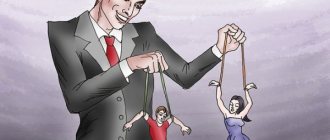The relationship between an individual and a crowd is one of the most problematic areas of modern psychology and philosophy. Although, of course, thinkers have paid attention to this phenomenon since ancient times. Crowd psychology allows you to interact with groups of people, knowledge of which has allowed some people to “rise above the whole world,” while others have at least gained inner independence.
What is a crowd and crowd psychology?
Belinsky defined the crowd
as “a collection of people living according to tradition and reasoning according to authority.” In general, this is the name given to a multitude of people united by some temporary, transitory factor. Such a factor could be some tradition, event, or general object of attention.
It is enough to look at any gathering of people on the street - shoppers in front of a new brand store opening, a meeting at a rally, fans at a stadium - and much will become clear. A crowd of people is a kind of spontaneous gathering, a short-lived community, which is characterized by chaos, although it is not without some organization. Understanding this organization allows certain forces to take this gathering into their own hands and force them to act together in a certain way.
Since there is a common unifying factor, all people in such a community are in a similar emotional state. A crowd of people is characterized by various parameters, including the number of participants, psychological and emotional state, direction of movement of the gathering, its speed, etc. In certain cases, a crowd of people can pose a danger both to others and to itself.
Thus, crowd psychology turns to the most chaotic, spontaneous, unorganized and dangerous social group, trying to find at least some patterns in its existence. Despite the mentioned qualities, this social group played an important role in human history.
Crowd types
Social psychology has developed several classifications of this social group.
For example, according to the degree of organization, the following types are distinguished:
:
- Spontaneous
. It arises spontaneously, has no leaders or any organizers in general. This could be, for example, a gathering of people on the subway. Although all these people have gathered for a specific reason, this gathering has no instigators. - Slave
. Such a crowd has instigators, it is organized by leaders. An interesting variety of such gatherings are flash mobs, which are organized via the Internet. In this case, a large group of people suddenly appears in one place, performs a certain action, and just as suddenly disperses. - Organized
. Such a crowd has a pronounced organization and orderliness. This concept was introduced by Gustave Le Bon, who believed that even such phenomena as a company of soldiers or a meeting of parliament are a type of crowd. Le Bon even attributed his own “soul” to such a gathering. Many psychologists strongly disagree with this concept and believe that only an unorganized group of people should be called a crowd.
Such gatherings are also divided according to the nature of people’s behavior
:
- Occasional crowd: a gathering of curious people - for example, in the case of a car accident.
- Conventional: people gather for a predetermined occasion (concert, football match).
- Expressive: people express general emotions (jubilation, protest, etc.).
- Ecstatic: Participants are overcome with ecstasy.
- Active: participants take active actions; this could be aggressive behavior, panic, a struggle for some values, opposition to the authorities.
Behavior patterns
Social phenomena manifest themselves in the masses. In addition to the differences, there are also common features. This is deindividuation - the partial disappearance of a person’s personal qualities, a state in which individuality is repressed under the influence of suggestions. There is a tendency to imitate. A person with this syndrome does not have a personal opinion or is afraid to express it. Follows the crowd, even if its interests do not correspond to his needs and moral values.
Another similarity is expressed in the sense of standardization. Because of this quality, a “herd instinct” develops. Aesthetic and legal norms are weakened. Gradually, a person loses his individuality and acts only according to the “rules” of the crowd.
Other general qualities.
- Feeling of your own strength. The sense of responsibility decreases. The participant does not always think ahead about the consequences when taking certain actions.
- Increased excitability in relation to one's own social feelings. The result is increased emotional impact. Each person in the crowd considers his point of view to be the only correct one, which can provoke a scandal. This is especially true for political or religious beliefs.
- Increased sense of persecution. Occurs when the participant realizes that he has done something wrong, illegal, etc. Manifests as a feeling of anxiety, which can later express itself as schizophrenia or a phobic disorder.
The crowd may disperse. This often happens under the influence of 2 factors. The first is the activation of the instinct of self-preservation or fear. It manifests itself in situations where a crowd is doused, an attempt is made to shoot at or destroy.
This often happens during rallies, when security services or representatives of other responsible institutions try to stop the angry crowd in any way.
Disconnection at will is the second factor. Possible reasons are hunger, prolonged exposure to the cold, late time of day. But after that, people usually gather again and continue to defend their interests.
Aspects of Crowd Psychology
What is a crowd man? It is quite obvious that he has to rebuild his consciousness to fit common values. In a human gathering, an individual loses his individuality, ceases to be a person. “Everyone ran - and I ran!” Often a person “returning” to a normal environment cannot clearly answer the question of why he performed certain actions; Indeed, in a large mass of people, an individual is often not aware of his actions, obeying a certain collective mind.
Such collective consciousness, however, was inherited by people by nature. In the animal world, collective behavior is represented very widely. Thus, birds in the same flock simultaneously fly up, as if on command. Ants spend their entire lives guided by a “single superintelligence,” which does not have a single carrier. The meaning of such mental organization is clear. After all, an ant individually is absolutely helpless; but even a small anthill can accommodate several million individuals, which turn into an almost invincible superorganism. As part of a close-knit team (more precisely, a gathering), animals can protect themselves from enemies and competing communities, prepare long-term food supplies, and build powerful residential and protective structures. Under such conditions, the impulse to “stick together” is automatically triggered, even if it contradicts the individual interests of community members.
Primitive people who lived in herds probably behaved the same way. Guided by instinct, emotion and collective intelligence, they were unaware of the complex philosophical concepts that we constantly encounter. In our time, the criterion of intelligence is considered to be independence, the ability to act alone or to freely unite in small groups for specific, carefully formulated reasons. Therefore, the man of the crowd today seems to us unreasonable, crazy, a wild idiot. In fact, in a huge spontaneous gathering in a human being, a person as such dies (a thinking, conscious, creating entity) and a wild beast, a biological principle, awakens (an entity driven by the simplest physiological impulses, according to “biological logic” called upon to preserve the community).
At the same time, the crowd man is entirely guided by emotions, and not by reason. And the more violent and violent the general emotions are, the more difficult it is for an individual not to fall under their influence. How can one explain the fact that a person is sincerely surprised by the madness of the crowd when he looks at it from a distance, and then connects to the general madness, finding himself in the same gathering? Apparently, the underlying motive for this is a feeling of freedom and permissiveness. This is very important - not freedom and permissiveness themselves (which, by and large, are absent in a spontaneous gathering of people), but their feeling.
The fact is that modern man is a student of civilization. In his physiological essence, he is an ordinary animal, having certain bestial impulses (although in the process of evolution his instincts are suppressed). But civilization puts a curb on man, forbidding him to follow these impulses and imposing abstinence. In most countries of the world, modern people do not even have the right to physical self-defense, or this right is severely limited: the state has a monopoly on violence. A person involuntarily feels depressed - after all, even if he escaped the attack of intruders, it was only because he, like a small child, was overshadowed by a powerful state.
The psychology of the crowd is such that it frees a person from such conventions and gives him the opportunity to “liberate himself.” Here you can give vent to accumulated negative emotions, tear apart an enemy (real or imaginary), and feel like a full-fledged master of your life. The person returns to his “natural state” and can behave in accordance with his “deep impulses”, which for a long time had to be hidden and suppressed. This is the feeling of boundless freedom, which in the conditions of a spontaneous gathering acts like a drug.
It happens that the effect of this drug is so strong that a person loses the remnants of his mind. And then what crowd psychology calls mass hysteria arises. At such moments, as Bekhterev put it, the gathering behaves “more stupidly than an individual, and ceases to be a collection of rational beings.”
How to control a crowd
Politicians, religious leaders and other active and ambitious people, using their knowledge of the psychology of the crowd, try to control it. This, of course, is an absolutely immoral and dishonest thing, however, on the other hand, the presence of a leader at the gathering to a certain extent reduces its danger. It seems simple to control the human element, because it, like any herd, is ready to obediently follow the leader. However, here lies the difficulty: a potential leader must be able to attract the attention of the participants in the elements, and this is very difficult to do in a storm of emotions.
Psychologists and political strategists use several methods to attract the attention of people in a gathering
:
- Demonstration of strength and power
. This is the use of the same animal model: members of a spontaneous community strive to rely on their strongest and bravest representative and follow him, because this subconsciously inspires security. Since the human element is a primitive phenomenon, the leader’s actions can be simple: it is enough to be taller than all other people, have brighter clothes, shout louder, etc. - Expressiveness of performance
. The leader’s speech should be loud and emotional, thereby setting the tone for the entire gathering and forming a “collective mind.” Therefore, not a single political or any other rally today is complete without technical means of sound amplification (megaphone, microphone, etc.). - "Clockwork" performance
. People in a spontaneous meeting are not ready to listen to long, lengthy monologues explaining all the facts and considerations; they require short and succinct phrases that convey not so much information as an incentive to action. Therefore, the main part of the leader’s speech becomes slogans that program the community.
It is typical that a potential leader should look like he belongs to the community. If this is an outsider, then it will be much more difficult for him to cope with the gathering. Therefore, provocateurs and instigators initially quietly penetrate into the raging community and follow the general mood, without showing themselves in any way, and only after some time they begin to stand out: they shout louder, shout out more aggressive slogans, use special sound and visual effects that force people to unwittingly turn to them attention (shots in the air, flags, unfolded posters, etc.). This behavior also allows you to reliably subjugate people in a gathering: by the time the provocateur comes out of his “hiding”, the people have already lost the remnants of their reason and obey only spontaneous reflexes. A provocateur can lead such a crowd anywhere, even to the point where its behavior contradicts the original plans. Thus, a skillful leader can force the people who came to the square to overthrow the government to dance a merry dance, pray to God, and clap their hands. When all the energy of the gathering is spent, it self-destructs: tired people will go home.
There are cases when the gathering is too passive and cannot be “stirred” with regular shots into the air. Then the provocateur begins to shoot not in the air. The contemplation of fresh blood and defeated comrades gives the gathering the necessary degree of aggression, driving it into a frenzy.
It is recklessness, emotionality, monotony of behavior, and unconsciousness that distinguish a crowd from a collective - a conscious collection of people. A person joins a team, guided by some personal considerations that he strives to defend in it. The team is capable of self-organization, a leader also appears in it, who is a member of this team, but here the leader does not have such unlimited power over ordinary participants. If the leader's decisions do not satisfy the wishes of the other participants, the team disintegrates; if someone does not agree with the general decision, he is free to leave the team without any special consequences for himself. In an organized team, each participant plays a role assigned to him and acts largely independently, but at the same time compares his actions with the common goal and the actions of others. In a spontaneous gathering, the leader’s task is to suppress the awakening individuality, block the minds of the participants and keep everyone “in the same direction.” He can launch a scheme like a “bucket of crabs,” when a spontaneous gathering will cleanse itself of “awakened upstarts.” It is known how crabs behave when placed in a bucket. Each of them could get out of it on his own, but when he reaches the top, the other crabs knock him down with their claws. Thus, in a spontaneous gathering, participants oust or physically destroy those who could lead the entire mass in the original direction, and the provocateur who deceived people, on the contrary, receives universal recognition.
A skilled provocateur can not only infiltrate an already prepared gathering, but also create his own. It can all start with a single picket: random passers-by are attracted by a person holding a poster or shouting a certain speech into a megaphone. In order to assemble his spontaneous “army,” a potential leader must understand the current political and economic situation and determine the mood of society. Here is an example of how you can create such an “army” almost out of thin air.
How was the cult of the Orthodox “saint” Matrona of Moscow created? At the very beginning of the “dashing nineties”, the revitalized Russian Orthodox Church had not yet fallen into “monstrum”, trying to preach primarily the ethical side of religion. However, the Russian Orthodox Church attracted little attention to itself, since it had a lot of strong competitors - various sects, healers, and psychics that flooded the country. They offered millions of desperate people what they had been waiting for for so long - miracles, or rather, faith in miracles. Witchcraft, magic, penetration into “forbidden territories,” communication with omnipotent supernatural beings - all this was much more interesting than boring Orthodox sermons about love, mercy and abstinence, especially since Orthodox teaching seems to categorically reject witchcraft practices. Even those who remained faithful to it during the harsh years of “scientific atheism” turned away from the Russian Orthodox Church: after all, the church gave believers hope, and the onset of the “wild nineties” after the collapse of the Soviet Union was perceived by them as the collapse of hopes: after the disappearance of the “evil empire” came an even greater “ evil,” in comparison with which the former Soviet regime seemed almost heaven on Earth. And under these conditions, the Russian Orthodox Church decided to act in a new way. She sanctioned the appearance in the church environment of the same “healer” and “miracle worker” as all these psychics and foreign spiritual leaders were. Various myths were composed about the “miracles” that Matrona performed both during her life and after her death. According to the church, the “holy” water from her grave, and flowers - again from the grave, had miraculous properties. Believers were encouraged to cut these flowers and add them to salads, and use them to prepare healing infusions. This large-scale action, in which hundreds of priests, monks and enterprising lay people took part, did its job: the people, thirsty for all kinds of miracles, flocked to churches. The income of the Russian Orthodox Church and its prestige rose sharply. The religious gathering did not even pay attention to the fact that in this case the Russian Orthodox Church grossly violated its own principles, committed a mass of mortal sins, recklessly engaged in charlatanism and crudely and primitively deceived people. Believers did not go into these details and did not even try to verify the hastily concocted legends and myths.
Another example is the story of how democratic Czechoslovakia suddenly, absolutely peacefully, became the most communist country in the world. At the end of the forties in Czechoslovakia, the local communist party was not particularly popular - the country developed in common with Western European countries. People could watch something terrible happening in the neighboring Soviet Union: massive artificial famine, repression, a totalitarian regime. And then the Czechoslovak communists began to give speeches in which they declared: they say that in the USSR they are building a “wrong” communism, and we will build our own, Czechoslovak and “correct” one. Propagandists adjusted to the general background and, together with the people, began to condemn the “Soviet system.” People liked it, and the communists won a landslide victory in the next elections. The very next day, communist leader Klement Gottwald began to build “Czechoslovak communism,” carefully copying the Stalinist model: repression, persecution of dissidents, militarization, bullying, ubiquitous propaganda and censorship. Residents of the country were shocked: they did not understand how they could vote for “this” in a single and friendly impulse. But even in subsequent years, Czechoslovakia was ahead of the rest in “communization”: the number of Communist Party members per hundred thousand inhabitants here was the largest in the world. This was also facilitated by the ability of political leaders to “come to an agreement” with the people.
Currently, political technology has reached its peak. As violence and open dictatorship are condemned and banned by the world community, politicians resort to subtle methods of controlling large masses of people in order to create the appearance of democracy. Today it can be difficult to distinguish the actual expression of the will of the people from actions at the behest of provocateurs. The most terrible thing is that the “people” themselves sometimes do not realize that they have long ceased to be the people and have turned into a frenzied gathering, carrying out the commands of a charismatic leader.
Basic recommendations
Being in a crowd can have a negative impact on a person's mental and physical health. Intellect and thinking are completely switched off when entering it. A person can do something that would never be repeated in a normal state. Neglects safety precautions, which leads to injury. Therefore, it is necessary to be able to protect yourself from exposure.
The main thing is to avoid the crowd. Often a person is not associated with the masses by any values. He can join only out of interest. But if a leader appears who knows how to control the masses, then the participant will be attracted by force. He will begin to fiercely defend the interests of the crowd, as a result of which he may suffer.
Below is how to behave if you get into a crowd.
- You need to behave calmly and not show aggression. Especially if the individual’s point of view is radically different from the community’s. Otherwise, from an ordinary passerby, he may become a victim of a huge number of often angry people. The best an individual can do in this situation is to pretend that he shares the values and ideas of the crowd. Then you need to try to smoothly and carefully leave the crowd.
- If the crowd begins to move, the task of a random participant in the procession is not to fall, to maintain balance. Otherwise he might be trampled. All clothes need to be tucked in, pockets zipped, things pressed tightly to you. If the situation has reached an extreme degree, it is better to get rid of unnecessary items. This will help save lives.
- If tear gas was used, quickly press anything against your face that is comfortable to breathe through. This could be a hood, scarf, scarf, hat. Be sure to close your eyes. Do not rub the skin around them. This will only make the situation worse. Try to get out of the crowd as quickly as possible and rinse your eyes with running water.
- If the police, national guard or other organizations are trying to pacify the crowd, try to get away from the epicenter of the events. If there is a wall nearby, move towards it. Do not resist law enforcement officers, behave calmly and with restraint. Otherwise, you may get injured or get shot. Screaming and calling for help is useless.
- Do not stand near the stage or other area where the speaker is speaking. This will make it difficult to get out of the crowd and make the space around you very limited and uncomfortable to stay in. Usually all events and fights begin near the stage or in the middle of the crowd. It is better to stay on the edge and try to quickly leave the scene.
- Avoid aggressive people. They may carry firearms or piercing objects. Usually they are in a state of alcohol or drug intoxication, i.e. they are not able to control their actions. Conflict situations with bad consequences often arise near such groups.
- Stick to the general flow rate. There is no need to try to go faster or push. This is especially important in panic situations when people are being evacuated. In case of a crush, bend your arms near your chest to protect yourself.
- When getting out of the crowd, do not get involved in verbal conflicts. Just silently leave the masses. It's better not to look at anyone. The behavior of aggressive people is unpredictable and always dangerous. You should also not respond to remarks addressed to you.
The main thing is not to lose your composure. Don't be manipulated. Behave naturally and try to keep your mind clear. As long as a person thinks, he is able to make the right decisions and save himself in a critical situation.











